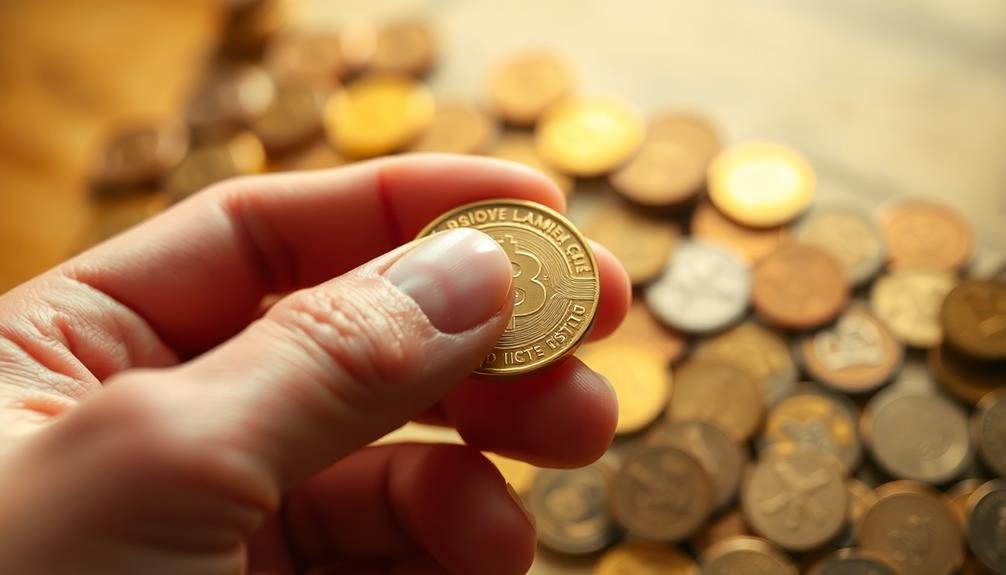Coin rubbing calms anxious collectors' nerves through a combination of sensory stimulation and psychological benefits. As you handle a coin, the tactile sensation grounds you in the present moment, redirecting your focus from worries. The repetitive motion induces a meditative state, similar to knitting or doodling, fostering a sense of control. Coins' smooth surfaces and unique textures offer a soothing tactile experience, while their historical significance adds depth to the practice. This simple act engages multiple senses, promoting mindfulness and stress relief. Coin collecting itself serves as a grounding activity, providing structure and accomplishment. Explore further to uncover the full spectrum of numismatic therapy's anxiety-reducing potential.
The Psychology Behind Coin Rubbing

The act of rubbing a coin for anxiety relief taps into several psychological mechanisms. First, it serves as a form of tactile stimulation, engaging your sense of touch and diverting your attention from anxious thoughts. This sensory focus can help ground you in the present moment, reducing worry about the future or rumination about the past.
Coin rubbing also provides a repetitive motion, which can be soothing and meditative. As you perform this action, your brain may enter a state of flow, similar to what's experienced during other repetitive activities like knitting or doodling. This state can lower stress levels and promote relaxation.
Additionally, the coin itself may hold personal significance or symbolism, acting as a tangible reminder of stability or good fortune. Your brain might associate the coin with positive memories or experiences, triggering a calming response.
The act of coin rubbing can also give you a sense of control in uncertain situations. By engaging in this deliberate action, you're actively doing something to manage your anxiety, which can be empowering. This perceived control, even over a small action, can help reduce overall feelings of helplessness or overwhelm.
Tactile Sensations and Stress Relief
Tactile sensations play a significant role in stress relief, extending beyond the specific act of coin rubbing. When you engage with objects through touch, you're activating your sensory receptors, which can help shift your focus away from anxiety-inducing thoughts. This redirection of attention can be particularly effective in calming your nerves.
The smooth, cool surface of a coin provides a unique tactile experience. As you run your fingers over its ridges and details, you're engaging in a form of sensory stimulation that can be both soothing and grounding. This physical connection to an object can help anchor you in the present moment, reducing feelings of worry about the future or rumination about the past.
Moreover, the repetitive nature of coin rubbing can induce a meditative state. It's similar to other stress-relieving activities like squeezing a stress ball or fidgeting with worry stones.
These actions provide a rhythmic, predictable sensation that can help regulate your nervous system and promote a sense of calm. By focusing on the texture and temperature of the coin, you're practicing a form of mindfulness that can effectively reduce anxiety levels.
Historical Significance of Coin Handling

Handling coins has been a part of human culture for millennia, stretching back to the earliest days of currency. You'll find that throughout history, people have cherished coins not just for their monetary value, but also for their cultural significance.
Ancient civilizations often used coins as a means of propaganda, featuring rulers' faces or important symbols on their surfaces.
In many cultures, you'd see people carrying lucky coins or rubbing them for good fortune. This practice dates back to ancient Rome, where people would touch statues of deities for luck. The tradition evolved to include rubbing coins, especially those featuring revered figures or symbols.
You'll notice that coin handling has also played a role in various rituals and ceremonies. In some cultures, coins are placed on the eyes of the deceased, while in others, they're tossed into fountains or wells as part of wish-making traditions.
Today, you might find yourself unconsciously fiddling with coins in your pocket, a behavior that connects you to this long history of human interaction with these small, portable pieces of metal.
Mindfulness Techniques for Coin Collectors
You can transform your coin collecting hobby into a mindfulness practice by incorporating simple techniques.
Focus intently on the intricate details of each coin, noting the textures, patterns, and inscriptions as you handle them.
As you examine your coins, practice tactile meditation by synchronizing your breath with the gentle motions of rubbing or turning the coin in your hands.
Focus on Coin Details
Frequently, coin collectors find solace in examining the intricate details of their prized pieces. When you're feeling anxious, take a moment to focus on the fine elements of your coins.
Start by selecting a favorite specimen from your collection. Hold it gently in your palm, feeling its weight and temperature.
Using a magnifying glass, explore the coin's surface. Notice the subtle textures, from the raised relief to the smooth fields. Pay attention to the tiny letters and numbers, observing how they're formed and placed.
Look for mint marks, designer initials, or other small identifiers. Examine the coin's edges, noting any reeding or inscriptions.
As you study these details, let your mind become absorbed in the craftsmanship. Consider the artistic skill required to create such intricate designs.
Think about the historical context of the coin and the stories it might tell. This focused observation can help quiet racing thoughts and bring you into the present moment.
Practice Tactile Meditation
Tactile meditation offers coin collectors a unique way to practice mindfulness. As you hold a coin in your hand, focus on its physical properties. Feel the weight, temperature, and texture of the metal against your skin. Notice the ridges along the edge and the raised details on both sides.
Close your eyes and run your fingers over the coin's surface. Can you identify the design elements by touch alone? Pay attention to the subtle differences between smooth and textured areas. As thoughts arise, acknowledge them without judgment and gently return your focus to the sensations in your fingertips.
Practice deep, slow breathing while exploring the coin. This combination of tactile stimulation and controlled breathing can help calm your nervous system. Try alternating between different coins, noting how each one feels unique.
You can also incorporate visualization techniques. Imagine the coin's history, picturing the hands it has passed through and the places it has been. This exercise combines tactile awareness with creative imagination, providing a multifaceted approach to mindfulness that's perfectly suited for coin enthusiasts.
Breathe With Coin Motions
Coin collectors can easily incorporate breathing exercises into their hobby by synchronizing their breath with coin movements. As you handle your coins, focus on your breathing and match it to the gentle motions of the coin in your hand. Inhale deeply as you lift the coin, hold your breath briefly as you examine it, and exhale slowly as you lower it back down. This rhythmic breathing pattern can help calm your mind and reduce anxiety.
Try these three mindfulness techniques while handling your coins:
- Coin flip breathing: Flip a coin repeatedly, inhaling as it rises and exhaling as it falls.
- Coin roll meditation: Roll a coin between your fingers, breathing in for one full rotation and out for the next.
- Coin stack breathing: Build a small stack of coins, inhaling as you add each coin and exhaling as you remove it.
Texture Variations Among Different Coins

You'll discover a world of tactile sensations when exploring the texture variations among different coins.
Start by examining the ridges and edge details, which can range from smooth to intricately milled.
Compare the surface finishes, from matte to mirror-like, and notice how denomination size differences affect the overall feel of each coin in your hand.
Ridges and Edge Details
When you explore the edges of different coins, you'll discover a fascinating world of textures and designs. Ridges and edge details aren't just decorative; they serve important functions and can greatly impact your sensory experience when handling coins.
Many coins feature reeded edges, with fine, parallel grooves running perpendicular to the face. These ridges provide a unique tactile sensation as you run your fingers along the coin's circumference. Some coins, like the U.S. quarter, have 119 reeds, while others, such as the dime, have 118.
Edge lettering is another intriguing feature you'll encounter. Some coins display words, dates, or symbols along their edges, adding an extra layer of complexity to their design. As you rotate the coin, you'll feel these raised or incused characters beneath your fingertips.
The importance of edge details extends beyond aesthetics:
- They help prevent counterfeiting by making coins harder to replicate.
- They assist visually impaired individuals in distinguishing between denominations.
- They protect the coin's design from wear and tear during circulation.
As you explore various coins, pay close attention to their edges. You'll find that these often-overlooked details can considerably enhance your coin-handling experience and provide valuable insights into each piece's history and purpose.
Surface Finishes Compared
Moving from the edges to the faces of coins, you'll encounter a variety of surface finishes that contribute to each piece's unique character. These finishes range from matte to highly polished, each offering a distinct tactile experience. Proof coins, with their mirror-like fields and frosted designs, provide a striking contrast that's both visually and physically satisfying. Uncirculated coins maintain a softer luster, while circulated pieces develop a patina that tells the story of their journey through countless hands.
As you explore different coins, you'll notice how their surfaces affect your sensory experience:
| Finish Type | Visual Appeal | Tactile Sensation |
|---|---|---|
| Proof | Stunning | Smooth, crisp |
| Uncirculated | Pristine | Subtle texture |
| Circulated | Weathered | Worn, comfortable |
| Matte | Subdued | Velvety |
| Burnished | Satin-like | Soft, uniform |
Each finish offers a unique way to engage with your coins, potentially soothing anxiety through focused exploration. The varied textures invite you to run your fingers across their surfaces, providing a grounding sensory experience that can help calm your nerves and redirect your attention from stressors to the intricate details of your collection.
Denomination Size Differences
Beyond surface finishes, the size and denomination of coins play an essential role in their tactile appeal. You'll notice that larger coins, like silver dollars or half-dollars, offer a more substantial feel in your hand, providing a greater surface area to explore with your fingertips.
Smaller denominations, such as dimes or pennies, present a different tactile experience, requiring more focused attention and delicate manipulation. These size differences contribute to the calming effect of coin rubbing by offering varied sensory inputs.
As you handle coins of different sizes, you're engaging multiple senses, which can help redirect your focus from anxiety-inducing thoughts. The weight disparities between denominations also add to this sensory experience, with heavier coins providing a grounding effect.
Consider these deeper implications of coin size differences:
- Larger coins may symbolize greater value or importance, potentially boosting confidence
- Smaller coins can represent attention to detail, encouraging mindfulness
- The variety of sizes mimics life's diverse challenges, reminding you of your adaptability
Collecting as a Grounding Activity
Collectors find solace in the methodical process of gathering and organizing coins. When you're feeling anxious, engaging in your coin collection can serve as a grounding activity, bringing you back to the present moment.
As you sort through your coins, you're focusing on tangible objects, which can help redirect your thoughts away from worries and stress. The act of cataloging your collection requires concentration and attention to detail.
You'll examine each coin's date, mint mark, and condition, creating a systematic approach that occupies your mind. This structured activity can provide a sense of control and accomplishment, especially when you're feeling overwhelmed by other aspects of life.
Coin collecting also offers a sensory experience. As you handle the coins, you'll feel their weight, texture, and temperature. This tactile engagement can be soothing and help anchor you in the present.
Additionally, the visual aspect of admiring your collection's diversity and historical significance can be both educational and calming.
Coin Rubbing Rituals for Anxiety

Rubbing a coin can serve as a simple yet effective anxiety-relief technique. As you hold a coin between your thumb and forefinger, focus on its texture, temperature, and weight. This sensory experience grounds you in the present moment, distracting your mind from anxious thoughts.
You'll find that the repetitive motion of rubbing the coin's surface can be soothing, much like a worry stone or fidget toy.
Create a personal ritual around coin rubbing to enhance its calming effects. Choose a special coin that holds meaning for you, perhaps from a significant year or place. Carry it with you as a portable anxiety-relief tool. When you feel stress building, take a moment to engage in your coin-rubbing ritual.
Consider incorporating these elements into your practice:
- Deep breathing: Sync your breath with the rubbing motion
- Positive affirmations: Repeat a calming phrase as you rub the coin
- Visualization: Imagine your worries being smoothed away with each stroke
Numismatic Therapy: Benefits and Practices
Numismatic therapy, a lesser-known form of anxiety relief, harnesses the calming power of coins and currency. This practice combines the tactile sensation of handling coins with the mental engagement of studying their history and design. You'll find that focusing on the intricate details of coins can redirect your thoughts away from anxious feelings.
To practice numismatic therapy, start by selecting a few coins that interest you. Examine their features closely, noting the texture, weight, and engravings. As you handle the coins, take deep breaths and allow yourself to become absorbed in their details. You can also research the coin's origin, mintage, and historical significance to further engage your mind.
Regular practice of numismatic therapy can lead to reduced stress levels, improved focus, and a sense of grounding. It's a portable and discreet method of anxiety management that you can use anywhere.
Additionally, this practice can foster a deeper appreciation for history and art, providing a rewarding hobby beyond its therapeutic benefits. By incorporating numismatic therapy into your routine, you'll develop a unique tool for managing anxiety while expanding your knowledge of coins and currency.
Frequently Asked Questions
Can Coin Rubbing Become Addictive or Compulsive Behavior?
Yes, you can develop a compulsive habit of coin rubbing. It's possible for this behavior to become addictive, especially if you find it soothing. You might find yourself reaching for coins more frequently to alleviate stress or anxiety.
Are There Specific Coins Recommended for Anxiety Relief?
You'll find that any coin can provide anxiety relief, but many prefer silver dollars or half dollars. Their weight and texture feel soothing. Some collectors swear by ancient coins, believing they carry calming historical energy.
How Does Coin Rubbing Compare to Other Stress-Relief Objects Like Fidget Spinners?
You'll find coin rubbing offers a unique sensory experience compared to fidget spinners. It's quieter, more discreet, and connects you to history. However, both can effectively reduce stress by providing a tactile distraction and repetitive motion.
Can Coin Rubbing Damage Valuable or Rare Coins Over Time?
Yes, you can damage valuable coins through excessive rubbing. It'll wear down the surface, reducing detail and value. You're better off using replicas or common coins for stress relief to preserve your rare specimens.
Are There Any Potential Health Risks Associated With Frequent Coin Handling?
You should be aware that frequent coin handling can pose health risks. You're exposed to bacteria and germs on coins' surfaces. There's also a risk of metal absorption through your skin, especially with older coins containing harmful metals.
In Summary
You've discovered the soothing power of coin rubbing. It's not just a quirky habit; it's a grounding technique that taps into your senses and history. As you feel the textures and contemplate the stories behind each piece, you're practicing mindfulness. Whether it's a daily ritual or an occasional comfort, this numismatic therapy can help calm your nerves. So next time anxiety strikes, reach for your collection and let the coins work their magic.





Leave a Reply